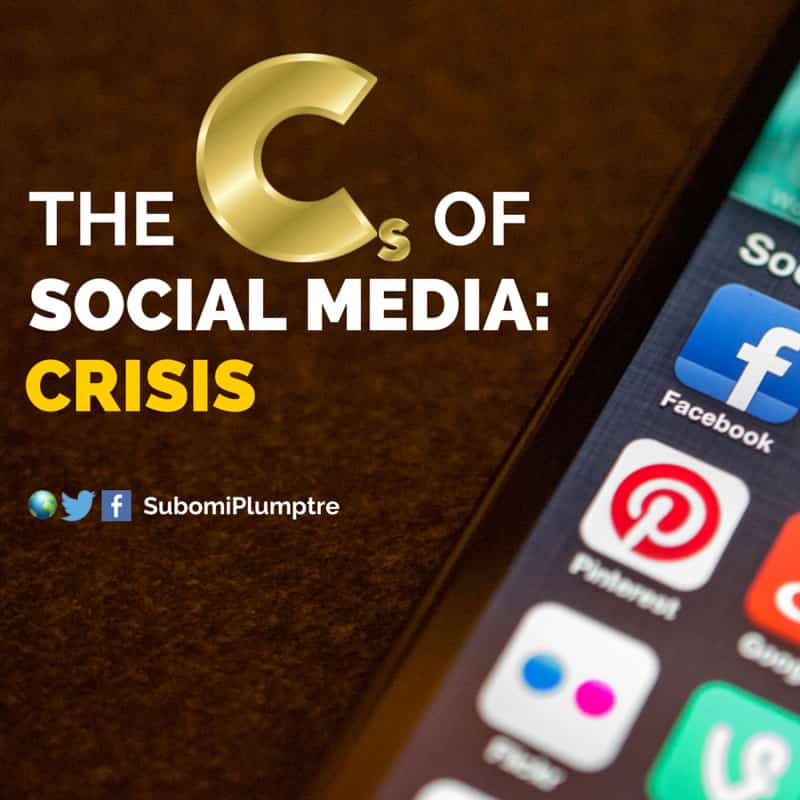Crisis: The Cs of Social Media
by Subomi Plumptre

Welcome to Episode 12 of The Cs of Social Media: Crisis.
So far, I’ve covered Concept, Context, Curation, Contributors, Creativity and Channel. I’ve also explored Calendar, Consistency, Content, Community and Conversation. (All previous editions of The Cs of social media are on my blog).
Today, I’ll talk about dealing with social media crisis.
Social media crisis primarily comes in two forms – those that begin offline (and are amplified online) and those that originate online. Offline initiated crisis could be a product defect, corporate scandal, unwise words spoken by an executive in public and so on. Online initiated crisis includes poor responses to inquiries, brand impersonators, hacks, scams, abusive parody accounts and the like.
Now, before a social media crisis ever happens, be preemptive by doing three things:
One: Protect your identity across all imaginable online platforms
Register your brand name on all platforms. For example, I own “subomiplumptre” on the online and social media platforms I care about.
Even if you don’t plan to use a platform at the moment, still go ahead to register it to preempt cybersquatters who may want to sell the platform back to you at a high price.
Use hard to guess passwords with a mixture of numbers, special characters and lower & uppercase letters. You may try using a variation for each platform so a single password doesn’t unlock all your accounts. Alternatively, you can use a password generator like LastPass.
Ensure your account recovery information is up-to-date in the event of a hack – your secret question, alternative email address, phone number etc. Some sites even allow you to set up a notification whenever your account is accessed by an unregistered device.
Finally, provide links to your online platforms from your website so people know your official accounts.
Two: Establish a social media crisis protocol
For large brands, it is advisable to develop a clear protocol on what to do in the event of a social media crisis. Many times this is embedded in the organisation’s larger PR or communications policy.
Your crisis protocol should state who can speak on behalf of the organisation and who is authorised to draft statements. The protocol should also advise on when a crisis should be escalated for resolution.
Three: Build an army of loyal followers
Build relationships online and keep your influencers close. In times of crisis, you will need people on your side who believe in you and can testify to your credibility or history, online.
Framework for Crisis Resolution
In the event of a social media crisis, here’s a simple framework you can use: DISAARMM.
Define the problem. State what the issue is to guide its resolution. For example, is a follower angry because an order was delayed or because a staff was rude when the incident was reported? Get to the root of the issue.
Identify the main agitators and influential voices. Who are the people stoking the fires of the crisis? What is their agenda?
Develop a clear Statement about your side of the story to clarify issues. Ensure it’s short enough to be understood, without the possibility of people taking things out of context.
Amplify your side of the story and make sure it’s at the top of your social feeds and comes up in Google searches on the issue.
Apologise if you are wrong and make amends.
Refer the Press or followers to your official statement if the issue lingers or is brought up in future.
Manage relationships. Sometimes you may need to take offline action by meeting with aggrieved parties or holding Press conferences.
Monitor the issue in real-time. In some cases, a situation room may be required to bring together key actors for quick decision making and implementation.
I sincerely hope the DISAARMM framework helps you.
I wish you success on your social media journey.


